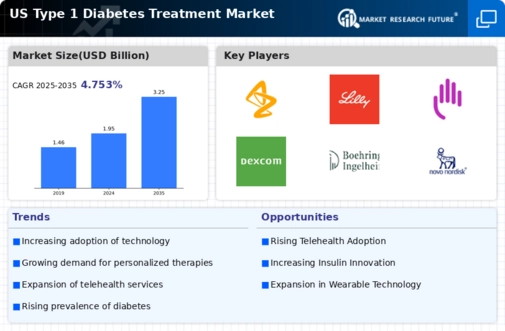Growing Awareness and Advocacy
The increasing awareness of type 1 diabetes and advocacy efforts are crucial drivers for the type 1-diabetes-treatment market. Organizations dedicated to diabetes education and support have been instrumental in raising public consciousness about the condition. Campaigns aimed at educating both patients and healthcare professionals about the latest treatment options and management strategies have gained momentum. This heightened awareness is reflected in the growing number of diabetes-related events and initiatives across the US. As more individuals become informed about the importance of early diagnosis and effective treatment, the demand for innovative therapies is likely to rise. This trend not only fosters a supportive community for patients but also encourages investment in research and development within the type 1-diabetes-treatment market.
Advancements in Insulin Formulations
Innovations in insulin formulations are significantly impacting the type 1-diabetes-treatment market. Recent developments have led to the introduction of long-acting and rapid-acting insulin products, which provide patients with more flexible and effective management options. For instance, the emergence of biosimilar insulins has made treatment more accessible and affordable, potentially reducing costs by up to 30%. These advancements allow for better glycemic control and improved quality of life for patients. Furthermore, the ongoing research into insulin delivery systems, such as smart pens and insulin pumps, is likely to enhance patient adherence and satisfaction. As these new formulations and delivery methods become more widely available, they are expected to drive market growth and reshape treatment paradigms in the US.
Increasing Prevalence of Type 1 Diabetes
The rising incidence of type 1 diabetes in the US is a primary driver for the type 1-diabetes-treatment market. Recent estimates indicate that approximately 1.6 million Americans are living with type 1 diabetes, a number that continues to grow annually. This increase is attributed to various factors, including genetic predisposition and environmental triggers. As the population of individuals diagnosed with this condition expands, the demand for effective treatment options intensifies. Consequently, pharmaceutical companies are investing heavily in research and development to create innovative therapies and insulin formulations. This trend not only enhances the treatment landscape but also stimulates market growth, as healthcare providers seek to offer the latest advancements in diabetes management to their patients.
Regulatory Support for Innovative Therapies
Regulatory bodies in the US are increasingly supportive of innovative therapies for type 1 diabetes, which serves as a significant driver for the type 1-diabetes-treatment market. The expedited approval processes for new drugs and devices, such as the FDA's Breakthrough Therapy Designation, facilitate faster access to cutting-edge treatments. This regulatory environment encourages pharmaceutical companies to invest in the development of novel therapies, including gene therapies and advanced insulin formulations. As a result, patients benefit from a broader range of treatment options that may improve their health outcomes. The proactive stance of regulatory agencies not only accelerates market growth but also fosters a culture of innovation within the type 1-diabetes-treatment market.
Integration of Telehealth in Diabetes Management
The integration of telehealth services into diabetes management is emerging as a vital driver for the type 1-diabetes-treatment market. Telehealth platforms enable patients to access healthcare professionals remotely, facilitating continuous monitoring and timely interventions. This approach has proven particularly beneficial for individuals managing type 1 diabetes, as it allows for personalized care and real-time adjustments to treatment plans. The convenience of telehealth services is likely to enhance patient engagement and adherence to treatment regimens. Moreover, studies suggest that telehealth can lead to improved glycemic control, which is essential for long-term health outcomes. As telehealth becomes more widely adopted, it is expected to play a pivotal role in shaping the future of the type 1-diabetes-treatment market.




















Leave a Comment